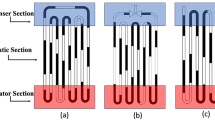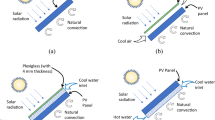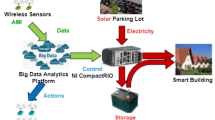Abstract
Cooling tower is crucial equipment in the cool-end system of power plant and the natural draft counter-flow wet cooling tower (NDWCT) gets wide application. The artificial neural network (ANN) technique is becoming an effective method for the thermal performance investigation of cooling towers. However, the neural network research on the energy efficiency performance of NDWCTs is not sufficient. In this paper, a novel approach was proposed to predict energy efficiency of various NDWCTs by using Back Propagation (BP) neural network: Firstly, based on 638 sets of field test data within 36 diverse NDWCTs in power plant, a three-layer BP neural network model with structure of 8-14-2 was developed. Then the cooling number and evaporation loss of water of different NDWCTs were predicted adopting the BP model. The results show that the established BP neural network has preferable prediction accuracy for the heat and mass transfer performance of NDWCT with various scales. The predicted cooling number and evaporative loss proportion of the testing cooling towers are in good agreement with experimental values with the mean relative error in the range of 2.11%–4.45% and 1.04%–4.52%, respectively. Furthermore, the energy efficiency of different NDWCTs can also be predicted by the proposed BP model with consideration of evaporation loss of water in cooling tower. At last, a novel method for energy efficiency prediction of various NDWCTs using the developed ANN model was proposed. The energy efficiency index (EEI) of different NDWCTs can be achieved readily without measuring the temperature as well as velocity of the outlet air.
Similar content being viewed by others
Abbreviations
- a :
-
actual output (experimental output)
- b :
-
predicted output (network output)
- c :
-
constant
- c w :
-
specific heat capacity of water/kJ·kg−1·°C−
- EEI :
-
energy efficiency index
- G a :
-
mass flow rate of inlet dry air/t·h−1
- H :
-
tower height/m
- H w :
-
central shaft water level/m
- h 1 :
-
specific enthalpy of inlet wet air/kJ·kg−1
- h 2 :
-
specific enthalpy of outlet wet air/kJ·kg−1
- h m :
-
average specific enthalpy of inlet and outlet air/kJ·kg−1
- h″ 1 :
-
saturated air enthalpy when temperature is equal to t1/kJ·kg−1
- h″ 2 :
-
saturated air enthalpy when temperature is equal to t2/kJ·kg−1
- k :
-
number of samples
- M :
-
number of neurons in the hidden layer
- MSE :
-
mean square error
- MRE :
-
mean relative error/%
- m :
-
number of neurons in the output layer
- n :
-
number of neurons in the input layer
- pA:
-
atmospheric pressure/Pa
- P e :
-
evaporative loss proportion/%
- Q L :
-
evaporation loss of water/t·h−1
- Q t :
-
circulating water mass flow rate/t·h−1
- R :
-
correlation coefficient
- S :
-
water-spraying area/m2
- t 1 :
-
inlet water temperature/°C
- t 2 :
-
outlet water temperature/°C
- Δt :
-
temperature difference of cooling water/°
- x :
-
moisture content of air/kg·kg−1
- x 1 :
-
moisture content of inlet air/kg·kg−1
- x 2 :
-
moisture content of outlet air/kg·kg−1
- α :
-
weight coefficient of EEI
- β :
-
weight coefficient of EEI
- γ :
-
weight coefficient of EEI
- Δε :
-
thermal balance error/%
- η :
-
cooling capacity/%
- θ :
-
dry bulb temperature of air/°C
- θ 1 :
-
dry bulb temperature of inlet air/°C
- λ :
-
air/water ratio
- μa :
-
mean value of a set
- μb :
-
mean value of b set
- τ :
-
wet bulb temperature of air/°C
- τ 1 :
-
wet bulb temperature of inlet air/°C
- ϕ :
-
relative humidity of inlet air/%
- Ω :
-
cooling number
References
Zhao Z.G., Cooling twers. Beijing: China Water & Power Press; 1996, pp. 3–4. (in Chinese)
Zheng W.Y., Zhu D.S., Zhou G.Y., Wu J.F., Shi Y.Y., Thermal prformance analysis of closed wet cooling towers under both unsaturated and supersaturated conditions. International Journal of Heat and Mass Transfer, 2012, 55(25–26): 7803–7811.
Jin T., Zhang L., Luo K., Fan J.R., Three-dimensional numerical study on thermal performance of a super large natural draft cooling tower of 220 m height. Journal of Thermal Science, 2013, 22(3): 234–241.
Alavi S.R., Rahmati M., Experimental ivestigation on thermal performance of natural draft wet cooling towers employing an innovative wind-creator setup. Energy Conversion and Management, 2016, 122: 504–514.
Mohanraj M., Jayaraj S., Muraleedharan C., Applications oartificial neural networks for refrigeration, airconditioning and heat pump systems-A review. Renewable and Sustainable Energy Reviews, 2012, 16: 1340–1358.
Mohanraj M., Jayaraj S., Muraleedharan C., Applications of artificial neural networks for thermal analysis of heat exchangers-A review. International Journal of Thermal Sciences, 2015, 90: 150–172.
Xu X.Q., Chen Z.Q., Study on economic optimal control strategy of ice storage air-conditioning system based on neural network prediction. Building Energy & Environment, 2018, 37(1): 1–5.
Naphon P., Wiriyasart S., Arisariyawong T., Nakharintr L., ANN, numerical and experimental analysis on the jet impingement nanofluids flow and heat transfer characteristics in the micro-channel heat sink. International Journal of Heat and Mass Transfer, 2019, 131: 329–340.
Hosoz M., Ertunc H.M., Bulgurcu H., Performance prediction of a cooling tower using artificial neural network. Energy Conversion and Management, 2007, 48: 1349–1359.
Islamoglu Y., Modeling of thermal performance of a cooling tower using an artificial neural network. Heat Transfer Engineering, 2005, 26(4): 73–76.
Xu Z.T., Mao J.C., Pan Y.Q., Huang Z.Z., Performance prediction of mechanical draft wet cooling tower using artificial neural network. Advanced Materials Research, 2015, 1070–1072: 1994–1997.
Wu J.S., Zhang G.Q., Zhang Q., Zhou J., Wang Y., Artificial neural network analysis of the performance characteristics of a reversibly used cooling tower under cross flow conditions for heat pump heating system in winter. Energy and Buildings, 2011, 43: 1685–1693.
Qi X.N., Liu Z.Y., Li D.D., Numerical simulation of shower cooling tower based on artificial neural network. Energy Conversion and Management, 2008, 49: 724–732.
Qi X.N., Liu Y.Q., Guo Q.J., Yu S.S., Yu J., Performance prediction of a shower cooling tower using wavelet neural network. Applied Thermal Engineering, 2016, 108: 475–485.
Gao M., Sun F.Z., Zhou S.J., Shi Y.T., Zhao Y.B., Wang N.H., Performance prediction of wet cooling tower using artificial neural network under cross-wind conditions. International Journal of Thermal Sciences, 2009, 48: 583–589.
Gao M., Shi Y.T., Wang N.N., Zhao Y.B., Sun F.Z., Artificial neural network model research on effects of cross-wind to performance parameters of wet cooling tower based on level Froude number. Applied Thermal Engineering, 2013, 51: 1226–1234.
Acceptance test specification of industrial cooling tower (DL/T1027-2006). Standards of Power Industry of the People’s Republic of China, 2006. (in Chinese)
Chen M., MATLAB neural network principle and essence of instance. Beijing: Tsinghua university press, 2013. pp. 164–165. (in Chinese)
Ma L., Zhao S.A., Zhang L.X., Comparative analysis of cooling tower thermal performance evaluation method. Journal of China Institute of Water Resources and Hydropower Research, 2017, 15(3): 213–217.
Qu Z.G., Yu J.H., Zhang J.F., Tao W.Q., Qi G.L., Liu X.M., Guan J., Energy efficiency measurement method of natural draft counter-flow wet cooling tower. Chinese Patent, Authorization number: CN 109030041 B. (in Chinese)
Acknowledgements
This work is supported by the National Key R&D Program of China (Grant No. 2017YFF0209803).
Author information
Authors and Affiliations
Corresponding author
Rights and permissions
About this article
Cite this article
Song, J., Chen, Y., Wu, X. et al. A Novel Approach for Energy Efficiency Prediction of Various Natural Draft Wet Cooling Towers Using ANN. J. Therm. Sci. 30, 859–868 (2021). https://doi.org/10.1007/s11630-020-1296-0
Received:
Published:
Issue Date:
DOI: https://doi.org/10.1007/s11630-020-1296-0




